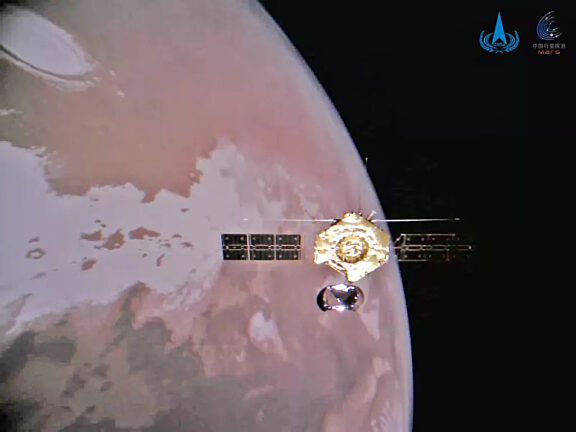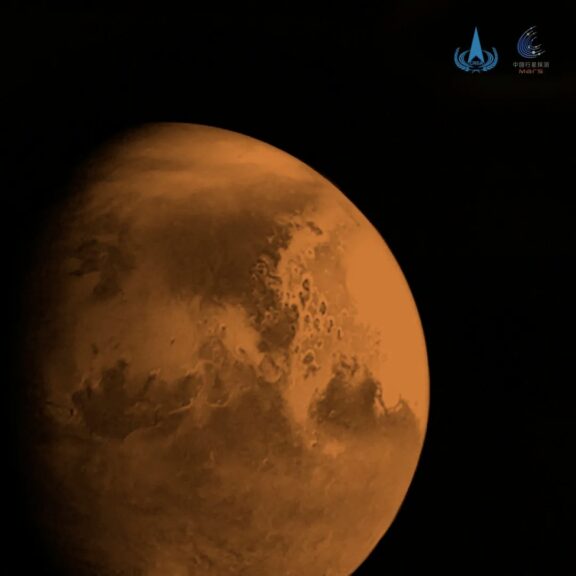Tianwen-3: China’s Mars sample return mission

Written by
Andrew Jones
Contributing Editor, The Planetary Society
September 15, 2022
Just over two years ago, China launched Tianwen-1, its first independent interplanetary mission, and stuck the landing on the red planet where it released its Zhurong rover. Only a few months after Tianwen-1 launched, China pulled off a complex lunar sample return mission, Chang’e-5. Now, it’s looking to combine elements of these missions to attempt an unprecedented Mars sample return in 2028.
Mars is considered one of the main candidates for a planet that could sustain life beyond Earth. While a number of missions with a vast array of instruments have been launched to and landed on Mars since the 1960s, some questions — such as identifying potential signs of past or extant life — can only be answered by examining Martian material in laboratories here on Earth.

What’s China’s plan?
China has stated its intention to conduct a Mars sample return mission for years, but only now, after its space program’s recent successes, are more solid details of the mission — called Tianwen-3 — emerging.
Earlier this summer, Sun Zezhou, the chief designer of China’s first Mars mission, gave a big update on Tianwen-3, which included unveiling new mission profiles, details about the spacecraft and their configurations, and some of the technologies involved.
The mission calls for a pair of launches in 2028 that would return a sample to Earth in July 2031. If successful, Tianwen-3 would be the first-ever robotic delivery of Mars samples to Earth. While NASA and the European Space Agency have proposed their own joint Mars sample return mission, it wouldn’t return to Earth until two years after Tianwen-3.
Tianwen-3 would use two spacecraft: one for landing and collecting, and another for orbiting and sample return. The landing segment would consist of a lander that would touch down on Mars to collect rock samples. It would also carry an ascent vehicle to send the collected material back into space.
Once in Mars orbit, the ascent vehicle would dock with the orbiter, which would be launched separately from the landing segment. The orbiter is tasked with escorting the samples back to Earth and would carry a return capsule designed for delivering the Martian material safely through a high-velocity, high-temperature reentry into Earth’s atmosphere.
There are currently two different mission profiles under consideration. In both configurations, two Long March 5 rockets — the same type of launch vehicle that carried Tianwen-1 and Chang’e-5 — would each launch one of the spacecraft. The orbiter would blast off from Wenchang on the island province of Hainan in November 2028.
The main difference between the two mission profiles is whether the lander launches before or after the orbiter. One profile calls for a December 2028 launch of the lander, which would arrive on Mars in July 2029 and spend about 6 months collecting samples. Alternatively, the lander could launch earlier — outside of the traditional low-energy Mars launch window — in May 2028, and land only in August 2030. In both profiles, the orbiter would arrive ahead of the lander, in August or September 2029.
A later landing could offer better solar energy conditions, avoiding winter in the Northern Hemisphere, but would allow less time — around three months — on the surface before the liftoff of an ascent vehicle in October 2030. Both mission profiles would see the orbiter depart from Mars and head home in October 2030, with touchdown of the samples on Earth scheduled for July 2031.
Earlier mission profile presentations suggested the use of a Long March 9, a super heavy-lift rocket currently under development that could be ready to fly around 2028. Another proposal was to use a Long March 5 and a Long March 3B. The switch to a pair of larger Long March 5 suggests there may have been changes to the lander design.
While China has not discussed its plans for landing sites, the earlier Tianwen-1 mission could be instructive since China already proved the technology needed to land in that region. The 2021 Zhurong landing took place in the flat, low elevation region Utopia Planitia in the Northern Hemisphere, which means the spacecraft had more time in the atmosphere to slow its descent. Landing at higher altitudes on Mars — as some NASA spacecraft have done — would require further refinements of entry, descent, and landing (EDL) technology and increase the complexity of the mission.
China built secure labs on Earth for handling its lunar samples, but it’s unclear at this point how it will address the needs and concerns of dealing with fresh samples from Mars. It’s also unknown just how much material China intends to bring home with Tianwen-3.

How did China get to this point?
China’s Long March 5 rocket is facilitating a lot of China’s space ambitions including Mars missions, lunar sample returns, south pole landings, building a space station, and even asteroid deflection concepts.
The successful Zhurong landing on Mars in May 2021 verified technologies and techniques needed to land on Mars, including a large supersonic parachute, guidance technology, and controlled retropulsion for landing in the unique characteristics of the Martian atmosphere and gravity field.
The Chang’e-5 lunar sample return demonstrated an automated remote launch from another world when the Chang’e-5 ascent vehicle blasted off from its lander in late 2020. But Mars will pose new challenges as it adds the complicating factor of having an atmosphere, which isn’t present on the moon.
It also involved an automated robotic rendezvous in lunar orbit between an ascent vehicle and orbiter, while two spacecraft were moving at around 1.2 kilometers per second (.7 miles per second). One reason China opted for this complex manner of getting lunar samples back to Earth instead of the direct return by Soviet Luna sample returns was to test out the necessary tech for the later Mars sample odyssey.
The sampling technology used by Chang’e-5 included a scoop for collecting surface material and a drill for obtaining samples from below the surface. Both techniques are expected to be used for the Mars mission.
The reentry capsule appears to borrow from the shape used for China’s in-development new generation crew spacecraft and also resembles plans for Tianwen-2 seen in the same presentation by Sun. That mission is expected to launch in 2024 or 2025 and attempt to sample the near-Earth asteroid Kamoʻoalewa (2016 HO3).

How does this differ from the NASA-ESA mission?
While China’s approach is very challenging technologically, it is still simpler than the Mars Sample Return mission conceived by NASA and ESA. For example, China’s Tianwen-3 mission will likely only collect samples from a single location, while the NASA and ESA joint mission would collect Mars samples from multiple locations.
Already, NASA’s Perseverance rover is collecting samples from a number of intriguing sites in Mars’ Jezero crater for delivery to a Mars ascent vehicle. The hope is that the diverse set of samples will have greater scientific payoffs when they’re returned to Earth.
The Perseverance mission has undergone recent changes, however, abandoning a planned European Space Agency (ESA) "fetch rover" and adding a pair of small helicopters as backups, following the success of Ingenuity. The move would reduce costs and complexity, according to a July 2022 update from NASA.
China has also unveiled its own version of a mini helicopter as an option for future Mars exploration. Sun Zezhou also presented a concept of a four-legged robot that could be used to sample sites farther from the lander.
Regardless of how the details of these Mars sample return missions change in the coming years, it seems that humanity might be taking two shots at gathering potentially scientifically seismic samples from Mars to Earth.
Support our core enterprises
Your gift today will go far to help us close out the year strong and keep up our momentum in 2026.
Donate

 Explore Worlds
Explore Worlds Find Life
Find Life Defend Earth
Defend Earth

